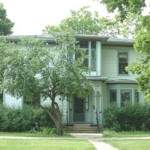 722 – 724 CHAPIN – PFEFFER HOUSE
722 – 724 CHAPIN – PFEFFER HOUSE
This house was built in 1874 by John B. Pfeffer, who lived in the house until his death sometime between 1915 and 1919. Pfeffer was an employ of Beloit College and loved by students and faculty. Edward Eaton described Pfeffer saying that “he regarded himself as in a true sense a colleague of the faculty,” and “he was always a friend of the ‘boys,’ indulgent of their pranks, welcoming them back as chums.” Hired as a janitor for Beloit College in 1864, he retained the position for more than 50 years. He took special pride in the care of the chapel, and was the bell ringer of the chapel and Middle College bells. His funeral was held in the College Chapel with students as his pall bearers.
The Pfeffer House was used as a boarding house. According to the 1886 city directory, a Christena Wicks, occupation domestic, boarded at 724 Chapin. Conveniently situated adjacent to the College, Pfeffer’s home was expanded in 1891 to house students. By 1896 the city directory shows two students, Thomas S. Huntley and Charles D. McConnell, living at 724 Chapin. In later years there were continuously two boarders with the Pfeffer family. By 1915, the boarders were F. Smith (a painter) and W. H. Dubbee (teacher at Beloit College). Since that time, the apartments in the house have been rented almost exclusively by college faculty.
This two story frame house is architecturally significant as an example of the vernacular late Italianate houses of the period which employed a variety of machine-produced wooden ornament to decorate an otherwise unrelieved facade. Based loosely on an L-shape, and enlarged throughout the 19th century, the house has a low-pitched hip roof with projecting eaves. Tall and narrow windows, regularly spaced, are framed with simple architraves. Thin corner boards and a frieze board outline the house while a modest variety of bay windows project from the east and west facades. The porch is particularly distinctive in detail especially at the north and east entries, which include turned posts with knobs, spindle friezes, and perforated brackets, detailing which anticipates the Stick-like and Eastlake ornament of later homes.